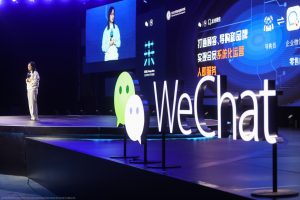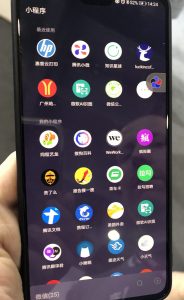I recently went to the WeChat Open Talk meeting, and founder Allen Zhang raised some questions that have really stuck with me. He talked about the increasingly important role of information flows in daily life and who controls this. His talk is here. My basic takeaway is the below question:
How do you manage the breadth and quality of information flows that are increasingly shaping our thinking and constituting so much our life experience?
And I think we can see at least two starkly different answers to this question right now. One from WeChat and one from TikTok, which I will outline below.
But first. . . consider joining my executive education course Jeff’s Asia Tech Class for deeper insights into China’s tech leaders from on the ground in Asia. There is a 30-day free trial.
Why information flows at scale are so important
In Part 1 of my visit to WeChat, I laid out four of Allen’s points about managing information flows at large scale. These are my words, not his.
- Information from smartphones now dwarfs information from our experiences in the real world.
- The breadth and quality of digital information a person receives is therefore becoming a critical issue.
- The biggest benefit of these digital information flows is an expansion and enrichment of social relationships.
- The biggest problem is information we passively consume without any decision-making, especially push notifications and newsfeeds.
The point is digital information flows (mostly via smartphones) are increasingly defining and shaping our lives. So the quality, quantity, and management of these flows is an increasingly important issue.
However. . .
There is a second side to this Allen didn’t mention. Before you can manage information flow as a service or company, you have to attract and keep people’s attention. And the things you do to achieve this may seriously impact the above four issues. What attracts people and what they want in the moment may not be good for them overall. Go to any supermarket and you will see some healthy food in the back (apples, milk, bread), but you will also see the front half the store full of potato chips, soda, alcohol, and candy.
So really there two important ideas here:
- Getting and retaining user attention.
- Managing the breadth and quality of information flows at scale.
That brings us to WeChat vs. TikTok, which are offering two starkly different answers to these questions.
Tencent vs. ByteDance –> WeChat vs. TikTok
Tencent and ByteDance are in increasingly direct competition for the time and attention of Chinese consumers. Tencent offers online gaming, music, videos, web pages, and messengers. ByteDance offers short videos, news aggregators, funny jokes, and probably music streaming. But they are focused on getting users’ attention and then keeping it. They both mostly monetize this through digital advertising (plus micro-purchases and gifting). And WeChat and TikTok are their two most popular products in this competition for attention.
So Tencent vs. ByteDance is a much more direct competition than say with Alibaba, which is more interested in getting your purchases and a percentage of your wallet.
WeChat’s approach: Provide useful tools
Allen Zhang really figured out social networks. He is kind of like Steve Jobs circa 1980. When the PC was just a vague idea, Jobs accurately predicted what it would become—a consumer tool used mostly for writing, photos, communicating, and games. IBM said it would be a tool for scientists. Other companies said it would be a business tool. Virtually all the other PC makers got it wrong in the first wave and died fast.

I think Allen got social networks right while Facebook, WhatsApp, and Twitter really went down the wrong path. Here is my assessment of Allen’s approach:
- Social networks are about connections and private chats. Most of our social interactions in real life are private conversations. We rarely say things or communicate to the broader public. So WeChat’s focus on one-to-one and small group private chats was spot on. And this was a big contrast to Facebook’s focus on posting lots of public comments and public updates.
- Private conversations, like the vegetables and milk at the back of the market, are both healthier and more honest. We are our normal true selves when talking to friends and colleagues privately. And doing more private chatting with friends does not make us unhappy. In fact, it makes us happy and better people.
- Public conversations and statements turn out to have lots of bad effects. First, we are usually not our true selves. We make ourselves into a fake, public version of ourselves. We only post photos that look good. We only say the good things (“I got a raise”). We look for feedback and validation. And there is lots of envy and showing off in public social networks. There are just lots of bad psychological effects. Notice the more you use Facebook and Twitter the more angry and envious you feel.
- Social networks should be useful tools and not a place for passive consumption. You get on WeChat, send a message to a friend, tell your work chat group what time the meeting is, make a payment, and then close it. Yes, WeChat wants your attention, but it doesn’t want you just sitting passively consuming content. Again, this is the opposite of Facebook, which basically wants you on their site all day mindlessly reading messages, posts, and notifications that are being automatically served up.

That is my interpretation of Allen’s idea for social networks. And I think you can see this in what WeChat has become. It’s mostly private conversations (one-to-one and group chat). There is some sharing within the social network, mostly through Moments and now Channels. But it is overwhelmingly about private communication and lots of useful tools, like payments and now mini-programs. There is only limited public commenting, newsfeeds, and push notifications. The percentage of the supermarket dedicated to alcohol and potato chips is relatively small.
Now compare all this to TikTok.
TikTok’s approach: AI gives consumers exactly what they want
There was a widely discussed article in the New Yorker by Jia Tolentino titled “How TikTok Holds Our Attention,” which is aptly titled. TikTok is 100% in the business of keeping your attention. That is what they do best. In fact, they have removed you entirely from the decision-making by having the AI run not only content recommendations, but also most of the decision-making.
I think there are four defining aspects of TikTok:
- It is not a social network like WeChat. It is more like YouTube in that it is an audience-builder platform that connects content creators with viewers. Who you know is not that important versus what you like to watch.
- The content type (short videos) are very effective for keeping attention and engagement. Short videos can be consumed like eating potato chips. One after the next after the next. The videos they show tend to have an emotional impact via dancing, music, and humor. They also use lots of music, which has an emotional impact. And the content runs on a continuous newsfeed that immediately tees up one video after the next.
- The AI engine (their strength) is focused on predicting what you most want to see next. And unlike YouTube, the AI also makes the decision for you. It doesn’t just make five recommendations for videos to watch. It automatically plays the next one for you. Minus a flick of the finger, it is 100% passive consumption.
- The content types are also designed to be viral and to get engagement by viewers. You can easily edit and share videos you watch. You can make your own videos. You can respond to challenges (“make your own catwalk video”). That gets you a lot of engagement and sharing. And it focuses the platform on what people most want to see, as determined by what they edit and share.
So if WeChat is about providing private communication and useful tools, TikTok is about feeding you an endless stream of what it thinks you want to see, regardless of quality. And it happens automatically via AI. It is like a gas station convenience store, 100% stocked with chips, soda, and alcohol. So they get lots of attention. But they have also repeatedly run into political issues about trivial, outrageous, and sometimes vulgar content.
A few more thoughts:
- TikTok videos are super easy to watch one after the next. It’s very addictive. There is a lot of powerful consumer psychology in short videos with music.
- Short videos get TikTok more data on what people like, because they flip through lots of them quickly. AI depends on lots of data, so this helps.
- Short videos are particularly easy for users to create or to build upon. A viewer can just turn the smartphone around and make their own video, or just edit and share an existing one. It is a very short step from viewer to content creator. And as I have been talking about in the Asia Tech Class, building a two-sided audience-builder platform (Daily Lesson – An Intro to Audience Builder Platforms) is a lot easier when you can convert one user group into the other.
ByteDance and TikTok are outstanding at attracting users and getting their time and attention. If WeChat is balancing attention and the breadth and quality of information flows, TikTok is a purebred in terms of getting your attention. These are starkly different visions for the future of our digital lives.
This article first appeared on Jeffrey Towson’s blog.

